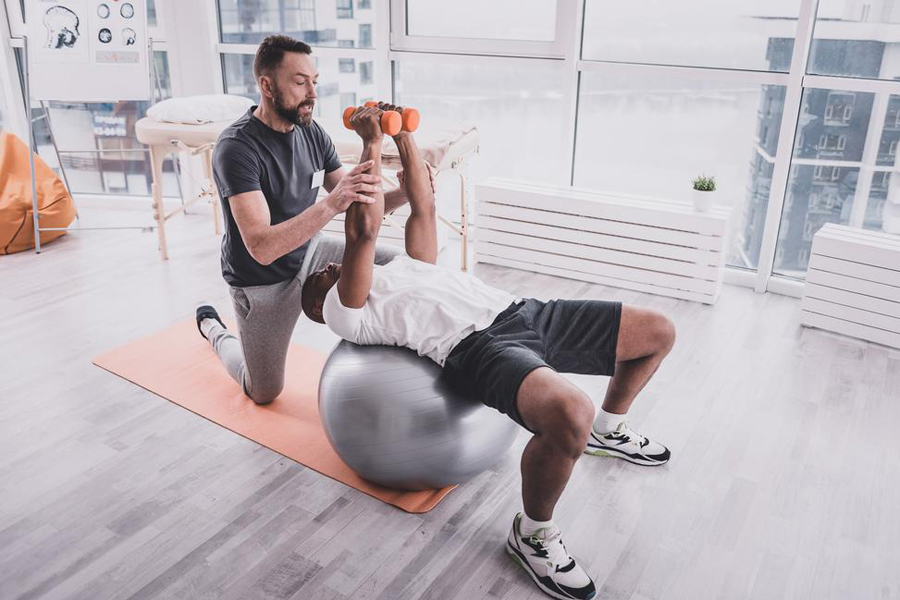Sponsored and written by Des Moines University Physical Therapy Clinic
Whether you’re an athlete or a weekend warrior, physical therapy can improve performance and prevent injury. Learn more about the different types of therapy and how it can benefit you.

May Help You Avoid Future Injuries
While physical therapists help you heal and get over injuries, their expertise can also help you avoid future injuries. Your therapist does this by considering:
- Your sport or activity’s physical demands
- Any past injuries
- Your weaknesses
Then, your therapist can create a custom plan for you, which includes exercises that can help you build strength and correct bad habits.
Therapists at clinics that specialize in sports injuries, use wearable technology and motion analysis to assess your unique biomechanics. These clinics often offer a running gait analysis or cycling analysis to pinpoint and correct your problematic areas.
“Every athlete wants to excel,” said Lauren Mach, Head Athletic Trainer and Physical Therapist for Des Moines University Physical Therapy Clinic.
“When we look at professional athletes,” Mach said, “they have several things in common: they work on the fundamental mechanics of their sport, participate in a strength and conditioning program, and activity engage in a recovery program to keep their bodies feeling great!”
By improving your mechanics, you’ll enjoy decreased strain and increased performance.
Relieves Pain
Athletes often have joint or muscle pain that a normal doctor can’t treat. Physical therapists are trained in a variety of techniques, which may include:
- Manual therapy, like joint mobilization and trigger point therapy
- Dry needling
- Applying kinesiology tape
These techniques are used in conjunction with customized exercises to relieve pain, restore function and help you avoid injuries later.
“However, it’s important to know that these techniques alone do not restore function or prevent injury,” Mach said. “Combining these techniques with a good strength and conditioning program, as well has addressing biomechanics deficits can be extremely powerful.”
May Help You Avoid Surgery
Working with a physical therapist may help you avoid painful and expensive surgery that takes a long time to recover from.
Types of Physical Therapy
Now that you know about how physical therapy can improve sports performance, learn more about the different treatment types. These treatments are used in conjunction with special exercises and education to change your movement patterns and achieve your goals.
Manual Therapy
As the name suggests, manual therapy is a hands-on approach for healing. It’s used by a variety of practitioners, including chiropractors, osteopaths and massage therapists.
Manual therapy includes:
- Joint mobilization and manipulation
- Strain-counterstrain
- Soft tissue mobilization
- Instrument-assisted soft tissue mobilization
- Myofascial release
- Visceral mobilization
- Trigger point release
- Dry needling
Your physical therapist will select the techniques that are best for you after a comprehensive evaluation.
Dry Needling
Dry needling uses tiny needles to enter the skin and underlying tissues to treat pain and muscle impairments.
It’s often used for:
- Neck, shoulder, hip or leg pain
- Lower back pain and sciatica
- Headaches
- Overuse injuries, muscle strains, tendonitis and bursitis
Dry needling is often used along with manual therapy, stretching and strengthening, as well as movement and balance exercises.
It has been shown to:
- Reduce pain
- Decrease muscle tension
- Increase range of motion
- Improve muscle therapy
Although needles are involved in this treatment, side effects are minimal. The muscle that’s being treated will involuntarily contract, which might feel like a dull ache or uncomfortable cramp. However, the feeling is temporary and only lasts a few seconds. Your muscles might feel sore after treatment, but ice, heat, gentle stretching or massaging the area can help relieve any lingering pain.
Kinesiology Tape
If you’re recovering from an injury or have a problematic area, kinesiology tape may help. During this treatment, your physical therapist will apply strips of special tape in specific directions. This may improve mobility because it provides extra support for joints, muscles and tendons.
Kinesiology tape is different from athletic tape, which is used for maximum support and limited motion. This tape is flexible so it can improve motion, decrease pain and improve circulation.
There are some different ways that kinesiology tape is used. Here are some of the most common:
- Improving athletic performance. Kinesiology tape can improve how your muscles flex and contract, which can boost your performance.
- Decreasing pain. If you’re dealing with an injury, this type of tape may reduce pain and keep your muscles from spasming.
- Providing extra stability. Dealing with plantar fasciitis, runner’s knee or a sore IT band? Kinesiology tape can provide extra support while still allowing the joint to move.
- Managing swelling and scar tissue. Taping can decrease swelling and provide greater range of motion.
Improve Your Performance by Working with a Physical Therapist
Whether you’re dealing with a nagging injury that’s affecting being active or want to set a personal record at your next 5K, working with a physical therapist can help. They have the expertise to create a customized treatment plan that addresses problems now and in the future.
About Des Moines University Physical Therapy Clinic:
Des Moines University Clinic Physical Therapy is the exclusive provider of physical therapy and athletic training services for the MidAmerican Energy Company RecPlex. Read more about physical therapy here and for their location.
